Mesa Verde: Architecture, Archaeology, Adventure
Posted on October 31, 2016 by bob in Travel
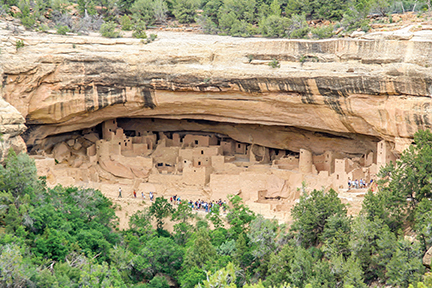
Cliff Palace is the largest dwelling in Mesa Verde with 150 rooms. It once housed approximately 100 people.
Story by Andrea Gross | Photos by Irv Green
I take a deep breath, reach for the side rails, and scramble up a ten-rung ladder. There before me is a small city, tucked into a shelf on a canyon wall, protected by a huge overhang. Some of the buildings are circular, like tall towers. Others are rectangular, with sharp, crisp angles; all are made of sandstone bricks and have small, open windows.
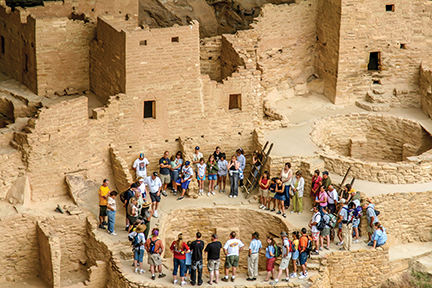
Kivas were used for religious purposes and as well as for political gatherings.
I’m in the Cliff Palace at Mesa Verde National Park, one of only 59 places the United States Congress has declared worthy of this designation. Here in the southwest corner of Colorado, using nothing but rocks and sticks as tools, an ancient people created not only a city, but an entire society. They farmed, prayed, made pottery and wove sandals for approximately 700 years, roughly 600 to 1300 AD.
There are more than 600 archeological sites at Mesa Verde, ranging in size from small one-room huts to large multi-storied compounds. They are so unusual, so well preserved and awe-inspiring, that in 1906 President Theodore Roosevelt signed a special Mesa Verde National Park Bill, granting protected status to the 52,000-acre site.
Ten years later the National Park Service was created to oversee the 84 million acres set aside “to preserve unimpaired the natural and cultural resources and values of [this country] for the enjoyment, education, and inspiration of this and future generations,” and Mesa Verde was officially put under the jurisdiction of the new agency. Today Mesa Verde is the only national park devoted exclusively to archeological remains and one of only fourteen national parks also designated as a World Heritage Centre.
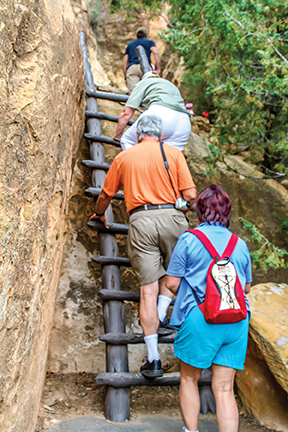
Visitors to Cliff Palace must climb five, 8- to 10-foot ladders.
Several of the remains are visible from roadside overlooks; a few can be explored independently; others can only be visited during Ranger-led tours. My husband and I begin with a tour through Cliff Palace, Mesa Verde’s largest cliff dwelling. We climb uneven steps and ladders, peer into alcoves, look down into kivas (circular structures used for religious, ceremonial or political purposes), and marvel at the architectural skill as well as the communal structure that existed so many years ago.
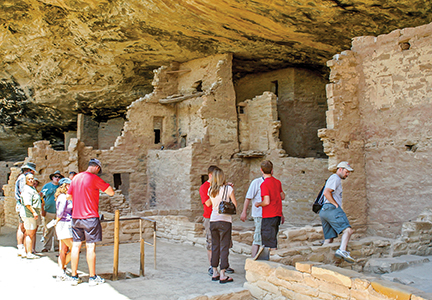
Rangers lead visitors through some of Mesa Verde’s most well-known ruins.
The actual walk through Cliff Palace is short, only about ¼ mile round trip, and the steps, though uneven, aren’t that steep. But the park is approximately 7,000 feet above sea level, meaning the air is thin and short walks seem long. For those who are reasonably fit — and who’ve taken a few days to acclimate themselves to the high elevation — the tour is worth every huff and puff. After Cliff Palace, we’re ready to tackle a more difficult site.
A sign at the Visitor Center encourages folks “to begin the day as the Ancestral Pueblo people have for generations.” I like the idea of getting into the skin of ancient people and am all ready to sign up for a tour of the Balcony House, when I read that I’ll not only have to climb a 32-foot ladder, but I’ll also have to crawl through an 18-inch-wide tunnel. It occurs to me that far from getting into the skin of the ancients, my hips might not even get into the tunnel.
I convince my husband to go to Wetherill Mesa instead so we can see Step House on a self-guided exploration that’s open to people of all ages — and presumably all hip widths — as long as they can carry ½ gallon of water. This is definitely more my style.
No one knows exactly why the ancient folks left the dwellings they’d so carefully constructed, but for the Pueblo people of the Southwest, who they were is no mystery. They claim the cliff dwellers as their ancestors.
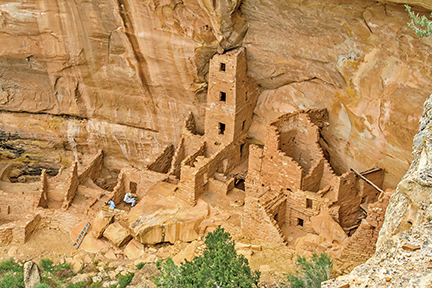
The Ancestral Puebloans were skilled architects and craftsmen.
Anasazi, the word previously used when referring to the inhabitants of Mesa Verde, is a Navajo word, given to them by those who discovered the deserted dwellings in the 1880s. It means “ancient ones,” but it implies, say today’s Puebloans, that the ancient ones were ancestors of the Navajo people rather than of the Puebloans.
What’s more, the Navajo word for “ancient” can also be translated as “enemy,” and today’s Pueblo people are understandably reluctant to have their ancestors described not only by a Navajo word, but by one that can be interpreted as meaning an enemy.
“That’s why we now call the cliff dwellers ‘Ancestral Puebloans,’” says a park Ranger. “It’s a more accurate description of who they were.”
Point well taken, although personally, I could have found an even better description. “Genius” is the one that comes to mind.
For an expanded version of this article as well as information on other Colorado attractions, go to www. traveltizers.com.









